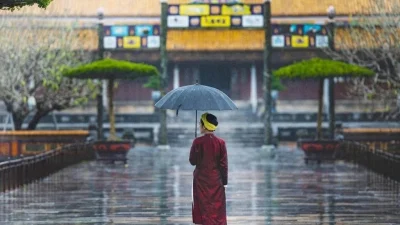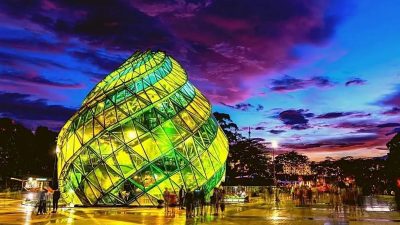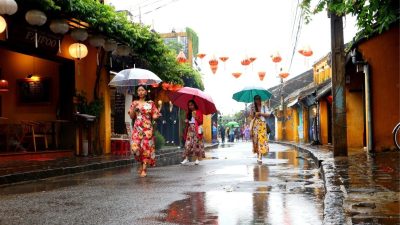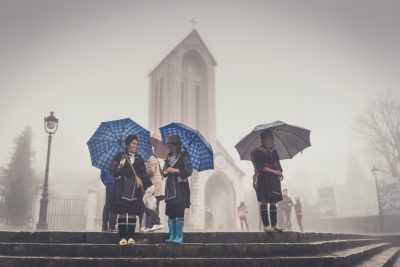
When planning a trip to Vietnam, many travelers want to experience the Vietnam Rainy Season Travel. Vietnam’s distinct S-shaped geography results in a variety of climates across its three main regions: the North, Central, and South.
While the heavy rains might seem discouraging, they add to Vietnam’s charm by bringing out the lush beauty of the landscape and creating a refreshing atmosphere. With careful planning, traveling during this season can be a unique and rewarding experience.
This guide will provide essential tips for making the most of your trip to Vietnam during the rainy season.
Vietnam’s diverse geography creates distinct rainy seasons in each of its three main regions—North, Central, and South—resulting in varying weather patterns. Understanding these differences is crucial for travelers who wish to experience the best of Vietnam, even during the monsoon season. Here’s a detailed guide on how the rainy season unfolds in each region.
The rainy season in Northern Vietnam lasts from May to October, coinciding with summer and the start of autumn. During this period, temperatures range from 28°C to 38°C, sometimes reaching up to 40°C in Hanoi, making it the hottest rainy season in the country. The region receives an average of 300 mm of rainfall, with the monsoon typically lasting 2 to 3 weeks, peaking between July and October. However, rain can still occur outside these months, with light spring drizzles in May offering a welcome relief from the heat. From July to September, downpours are brief but intense, often lasting around 30 minutes. In autumn, rains can persist for up to 30 days.
Due to climatic differences between the coastal plains and the mountains, Central Vietnam experiences two rainy periods. The coastal plains see rain from September to December, while the mountains receive rainfall from May to August. This region is often hit by severe storms that can cause flooding, especially in Hue, Nha Trang, Da Nang, and Hoi An, where rainfall peaks between October and December. During these months, floods can disrupt sightseeing, and in some areas, locals and tourists alike may have to use small boats to get around, which can be a unique travel experience.
In Southern Vietnam, the rainy season generally starts between April and October, with the heaviest rains occurring in June, July, and August. The region sees an average of 11 inches of rain per month, but showers are usually brief and heavy, rarely lasting longer than three hours. This means that rainfall is unlikely to significantly impact your travel plans. A helpful tip: if you're visiting the Cu Chi Tunnels, plan your trip for the morning, as rain is most common in the afternoon.

For long-distance travel in Vietnam, airplanes, trains, and buses are the most practical options. Once you reach your destination, renting a motorbike is a popular choice for exploring. However, safety should always come first. Drive at a moderate speed, follow traffic rules, and avoid riding at night, as roads can be slippery and visibility reduced.
If you encounter hazardous conditions such as lightning storms or flash floods, immediately stop and seek shelter in a safe place. Always inspect your motorbike before heading out, ensuring it’s in good working condition. Opt for a helmet with a visor to protect your face from the rain, reducing the risk of irritation and improving visibility on the road.

The rainy season in Hue lasts from September to December. Traveling to Hue during this period offers visitors the chance to experience the city's magnificent and poetic landscapes, filled with emotional depth. One of Hue’s most notable attractions is the Complex of Hue Monuments, which takes on an ethereal beauty under the rain. The heavy showers reflect the authentic charm of Hue's ancient past, creating a melancholic yet enchanting atmosphere.
In the cool, rainy weather, you can also indulge in Hue's famous comforting dishes like beef noodle soup or relax by sipping tea on the banks of the romantic Perfume River. This makes for an unforgettable experience of Hue's unique rainy-season ambiance.

Starting in early August, the first rains signal the beginning of the rainy season in Da Lat, which lasts until mid-October. The rains here are neither too heavy nor persistent, but they add a romantic touch to the city’s landscape. The roads lined with yellow wildflowers and mimosas take on a special charm during this period, evoking deep emotions in those who visit.
Highlights of a trip to Da Lat during the rainy season include visiting Prenn Waterfall, exploring the Da Lat Flower Garden, and wandering around the Maple Leaf Forest. These sites are especially captivating during the gentle rains, making this mountain city a must-visit during this season.

When visiting Central Vietnam during the rainy season, Hoi An is not to be missed. Strolling under an umbrella through the ancient town, with its golden walls and colorful lanterns, creates a highly poetic and serene scene. The rain adds a special charm to the old houses and quiet streets.
If the rain is too heavy and the town floods, don’t worry—you’ll have the unique opportunity to explore Hoi An by boat. On full moon nights, the town shines with the glow of lotus flowers and lanterns floating along the Hoai River, offering a magical, dreamlike experience.
Read more: Hoi An Vietnam Travel: Top Attractions & Essential Tips

Phu Quoc’s rainy season spans from April to October, with frequent sudden showers occurring between July and September. Despite the rain, traveling during this season offers unique experiences. The island is quieter, with fewer crowds, allowing for more relaxed sightseeing and dining.
This period also brings great discounts on flights, accommodations, and tourist packages, making it an affordable time to visit. One of the best things about the rainy season in Phu Quoc is swimming in the calm, clear waters at Bai Sao and Bai Khem—beaches that are most enjoyable during this time. Additionally, it’s the season for harvesting Tram mushrooms, a local delicacy that you can buy as gifts for family and friends.

The rainy season in Moc Chau is the best time to witness the beauty of Dai Yem Waterfall. The water cascades down from Suoi Vat and other sources, resembling a ribbon of white silk flowing through the lush green mountains. Viewing the majestic nine-tiered waterfall from a nearby hilltop offers a breathtaking panorama.
During this time, you can also visit the lush green tea plantations like Shan Tuyet and the heart-shaped tea hills on the way to Ngũ Động Bản Ôn. Despite the rainy weather, the region’s landscapes offer an entirely new and refreshing experience for those willing to explore.

Sapa’s rainy season starts in May and lasts until late August or early September. The high levels of rainfall during this time create a magical setting as Sapa enters its "water-pouring" season. The terraced fields in Ta Van, Lao Chai, Ta Giang Phinh, and Suoi Thau glisten like mirrors reflecting the sky, adding to the natural beauty of the region.
While the rain may limit sightseeing opportunities, it also brings unique pleasures. Gather around a warm fire with friends to grill local specialties like "lon cap nach" (a small mountain pig) and stream fish, paired with a glass of sweet and fragrant apple wine. The combination of warm food, drinks, and good company makes rainy-season travel in Sapa a truly cozy and memorable experience.
Read more: Sapa Vietnam Travel Guide: Explore the Stunning Highlands
To ensure a seamless travel experience, we offer Vietnam visa services, making your journey to Ha Giang and beyond hassle-free.
We provide fast Vietnam tourist visa services in as little as 1 hour